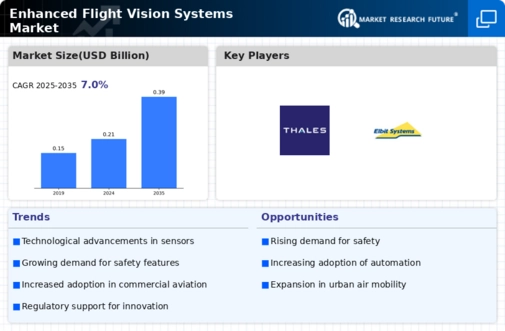Market Analysis
In-depth Analysis of Enhanced Flight Vision Systems Market Industry Landscape
The Enhanced Flight Vision Systems (EFVS) market operates within a dynamic framework shaped by several key factors that influence its growth and evolution in the aviation industry. One of the primary drivers of this market is the increasing emphasis on improving flight safety and operational efficiency. EFVS technology enhances a pilot's ability to see and navigate in challenging weather conditions, such as low visibility, fog, or darkness. As aviation stakeholders prioritize safety measures, the demand for EFVS solutions rises, allowing pilots to make informed decisions and conduct safer landings and takeoffs.
Technological advancements play a pivotal role in shaping the market dynamics of Enhanced Flight Vision Systems. Continuous innovations in sensors, imaging technologies, and display systems contribute to the development of more advanced and capable EFVS solutions. These systems typically include infrared sensors, synthetic vision technology, and head-up displays, providing pilots with real-time, enhanced images of the external environment. The dynamic nature of technology-driven improvements positions EFVS as a critical element in modernizing aviation safety and navigation.
Regulatory considerations are crucial factors influencing the market dynamics of EFVS. Aviation authorities, such as the Federal Aviation Administration (FAA) and the European Union Aviation Safety Agency (EASA), establish standards and regulations for the certification and use of EFVS in commercial and business aviation. Compliance with these regulations is essential for EFVS manufacturers and operators, ensuring the safety and reliability of these systems. The alignment of EFVS technology with regulatory standards is critical for market acceptance and widespread adoption within the aviation industry.
The competitive landscape within the EFVS market is characterized by the presence of major avionics manufacturers, technology providers, and aviation stakeholders. Intense competition fosters innovation, with companies striving to offer advanced EFVS solutions that provide superior performance, ease of integration, and enhanced safety features. Collaborations and partnerships between EFVS manufacturers and aircraft manufacturers contribute to market dynamics, enabling the seamless integration of EFVS technology into modern aircraft cockpits.
Global economic factors significantly impact the EFVS market. Economic growth, increasing air travel demand, and the expansion of commercial and business aviation contribute to the adoption of EFVS solutions. Airlines and operators seek to enhance their fleets with technologies that improve safety and operational capabilities. Conversely, economic downturns or disruptions in air travel demand may influence investment decisions and impact the overall market outlook for EFVS solutions.
The market is further influenced by the growing trend of retrofitting existing aircraft with EFVS technology. As aviation stakeholders recognize the benefits of EFVS in improving safety and operational efficiency, there is a growing market for retrofitting older aircraft with modern EFVS solutions. This trend creates opportunities for EFVS manufacturers and service providers to offer upgrade packages, extending the applicability of EFVS technology to a broader range of aircraft.
Environmental considerations are becoming increasingly relevant in the EFVS market. As the aviation industry seeks to reduce its environmental impact, EFVS technology contributes to more fuel-efficient operations by enabling safe landings and takeoffs in adverse weather conditions. The environmental benefits of EFVS align with broader industry goals to enhance sustainability, creating opportunities for market players to position their solutions as contributors to greener aviation practices.






Leave a Comment